ISSN
2307–3489 (Print), ІSSN
2307–6666
(Online)
Наука та прогрес
транспорту. Вісник
Дніпропетровського
національного університету залізничного
транспорту, 2017,
№
1
(67)
автоматизовані
системи управління на транспорті
автоматизовані
системи
управління на транспорті
udc
656.259.1:517.443
O. O. HOLOLOBOVA1*,
V. I. HAVRYLIUK
2
1*Dep.
«Automation, Telemechanics and Communications», Dnipropetrovsk
National University of Railway Transport
named
after Academician V. Lazaryan, Lazaryan St., 2, Dnipro, Ukraine,
49010, tel. +38 (056) 373 15 04,
e-mail
gololobova_oksana@i.ua, ORCID 0000-0003-1857-8196
2Dep.
«Automation, Telemechanics and Communications», Dnipropetrovsk
National University of Railway Transport
named
after Academician V. Lazaryan, Lazaryan St., 2, Dnipro, Ukraine,
49010, tel. +38 (056) 373 15 04,
e-mail
gvi_dp@mail.ru,
ORCID 0000-0001-9954-4478
APPLICATION of Fourier transform
and Wavelet
decomposition for decoding
the continuous automatic LOCOMOTIVE
signaling code
Purpose. The existing system of automatic
locomotive signaling (ALS) was developed at the end of the last
century. This system uses the principle of a numerical code which is
implemented on the basis of relay engineering, and therefore, it is
exposed to various types of interferences. Over the years, the system
has been upgraded several times, but the causes of faults and
failures in its operation are still the subject of research. It is
known that the frequency and the phase modulation of signal has a
higher interference immunity as compared to the amplitude modulation.
Therefore, the purpose of the article is to study the possibility of
using the frequency methods such as Fourier series expansion and
wavelet decomposition to extract the informational component of the
received code from ALS signals under the action of various types of
interferences. Methodology. One can extract the information
unavailable in time representation of the signal using the signal
studies in the frequency domain. The wavelet decomposition has been
used for this purpose. This makes it possible to represent the local
characteristics of the signal and to provide time-frequency
decomposition in two spaces at the same time. Due to the high
accuracy of the signal representation it is possible to analyze the
time localization of spectral components and eliminate interference
components even in the case of coincidence of interference frequency
with the signal carrier frequency. Findings. To compare
informativity of the methods of Fourier expansion and wavelet
decomposition it was studied the reference and noisy signal of green
fire code using the software package MATLAB. Detailed analysis of the
obtained spectral characteristics showed that the wavelet
decomposition provides a more correct decoding of the signal.
Originality. Replacing the electromagnetic relays in the ALS
system by microprocessor hardware involves the use of some
mathematical tool for decoding, in order to obtain more information
about the code. More often than not, as a mathematical tool, the
classical Fourier decomposition is used. But because of a number of
drawbacks in this method, it was suggested to use the wavelet
decomposition, which has a number of advantages and accounts the
disadvantages of the Fourier transform. Practical value. The
presented method of code signal research can be the basis for
developing dynamic model of the ALS receiver and decoder using
digital processing module, which will enable to increase the
reliability and accuracy of extraction of the code information
component.
Key words: automatic locomotive signaling;
Fourier transform; wavelet decomposition; interference immunity;
amplitude modulation; shift; scale; time-frequency domain
Introduction
The existing system of automatic locomotive signaling of continuous
action (ALSC) has been developed and started to operate more than 40
years ago. It was built using electromagnetic relay with a numeric
code, and has significant disadvantages in spite of a series of
upgrades.
The disadvantages of the system include: the limited informative
value (three code dispatches and five signal indications on
locomotive light-signal); indications of the locomotive light-signal
do not reflect the speed limit of passing of traffic guide lights
and station lights, depending on the length of the block section and
the required speed limit on it; low reliability of locomotive
devices is due to the coding by amplitude modulated signal, which
has low interference immunity. It is subjected to changes in the
duration of the pulses and pauses, which causes failures when
applying the codes for a locomotive. The system can receive codes
from the next track. It is impossible to use it on the high-speed
sections because of the low information content and large inertia
[2, 24].
ALSC signaling occurs in specific conditions, peculiar only to this
system. Firstly, the signal in each track circuit is transmitted
only from its own source and its level in the rails continuously
increasing as the train moves. Secondly, the locomotive transition
from the one track circuit to another is accompanied by a short
interruption in the track signal reception and a dramatic decrease
of signal current in the rails. In addition, track circuits,
connecting the moving locomotive with the signal transmitter are
simultaneously used both in the auto-lock system and on the
electrified railways to pass the reverse traction current. The
sources of harmonic interferences are the traction substations and
the networks of direct and alternating current, as well as the
traction drive of locomotive. This particularly applies to electric
drives with asynchronous traction motors widely used in recent years
[8].
The problems of protection from the main sources of interference at
the railway transport, which lead to failures in the operation of
signaling and communication equipment, their research and
identification, were considered in numerous scientific studies, but
they are still relevant [23].
It is known that the amplitude modulation which is used in ALSC for
transmission of numeric code combination has low interference
immunity as compared to the frequency and phase one. This is
explained by the so-called passive pauses, i.e. the lack of signals
in the pauses. As a result, upon the receipt of code combination the
total signal energy in a cycle is proportional to the ratio of the
total duration of all pulses and the duration of code combination.
Thus, the difference in energy level of different ALSC codes is from
6 to 11 dB.
Applicable coding principle also has some disadvantages, which do
not allow the use of well-known schemes for constructing an optimal
receiver. Discrete signal transmission theory is based on the
concept of a symbol having a predetermined duration, frequency, and
it is not applied to code combinations of the ALSC system.
Consequently, it is impossible to use the systems of clock and frame
synchronizations, pulse distortion equalizers. For this reason, the
interference immunity is reduced almost by 6 dB.
Another factor influencing the interference immunity of ALSC
receivers is the signal degradation associated with the carrier
frequency. As a rule, filter systems of data transmission in the
signals should contain at least eight periods of carrier for each
symbol. The exception is the systems with the minimum phase
modulation types, operable with a signal/interference ratio at least
20 dB, which cannot be achieved in the channel ALSC. The pulse
duration «RY» transmitter KPT-5 is about 0.23 seconds. When a
carrier frequency of 25 Hz in a pulse will be at least six periods.
The amount of signal degradation in this case is 0.8, i.e. its
capacity is reduced by 2 dB.
The amount of losses of the interference immunity of the system is
14 dB. Accordingly, the error probability is increased tenfold as
compared to the optimal receiver.
The analysis shows that in ALSC system especially at a frequency of
25 Hz it in principle impossible to obtain high interference
immunity [7].
In addition, the railway lines almost always have a longitudinal
traction current asymmetry that arises, for example, when breaking
the wire rail-bonds or when connecting to one of the rails the
earthings of traffic lights supports, masts, and other metal
constructions. Therefore, with the electric traction the track
transformer core is magnetized by the traction current. During the
train movement the current value is changing, and the parasitic
modulation of signal current by the traction one takes place. In
connection with this the increase in signal current is not always
effective and sometimes it results in increase of ALSC failures. It
should be noted that with the advent of more powerful locomotives,
this phenomenon has become even more pronounced [19, 20].
Purpose
In view of the above mentioned the work is aimed to study the
possibility of using the frequency methods (Fourier transform and
wavelet decomposition) to increase the reliability and credibility
of extraction the informational component of the received code from
amplitude-modulated ALSC signals under the action of various types
of interferences. The implementation of this research in the future
may be the basis for the development of a new receiver of the ALSC
system with improved interference immunity.
Methodology
In the existing ALSC system the principle of operation of decoding
devices is based on the analysis of amplitude and time
characteristics of the received signal. Information value is the
number of pulses in the signal, and the protective one is a long
interval at the end of the code. On this basis, shortening or
lengthening pulses and intervals, filling the long interval or
numerical distortions can lead to incorrect reception of the code
[3, 6].
Often the information, which is not noticeable in
the time representation of the signal, is shown in its frequency
representation. Using the Fourier transform (FT) one can study the
noisy ALSC code signal comprising interferences from various
sources. With the use of FT, a signal is decomposed into elementary
harmonic vibrations with different frequencies and all the necessary
properties and formulas are expressed using one basis function
exp(jωt)
or two real functions sin(ωt)
and cos(ωt).
This gives the spectral information about the signal and describes
its behavior in the frequency domain [16, 17, 21, 22].
The Fourier transform is described by the formula:
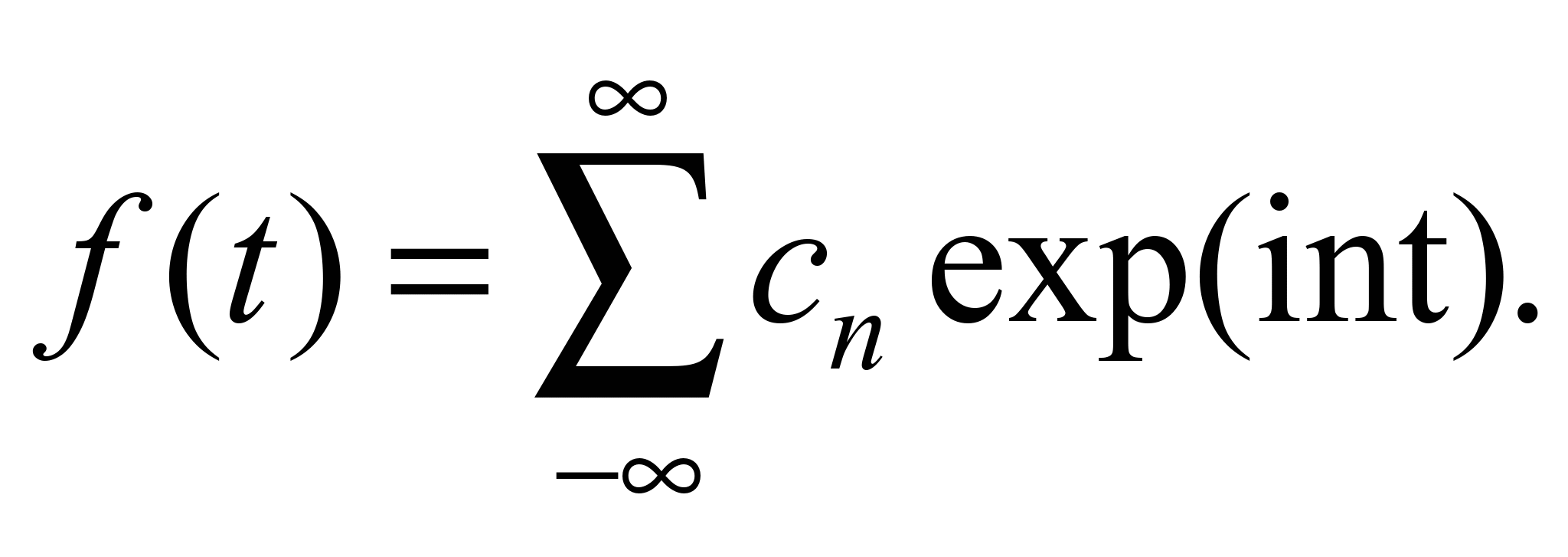
in which the basis function is:
 ,
,
As a result of the ALSC signal decomposition it is obtained the
basic carrier frequency 25, 50 or 75 Hz (depending on the type of
track circuits) and interference frequency. Based on the method of
correlation reception according to spectral feature in the
amplitude-frequency dependence appropriate ALSC codes can be
recognized. But it should be noted that the FT makes it possible to
determine the frequency content of the signals, but one cannot
determine at what time point there is one or another frequency. This
makes the method of spectral analysis unusable for processing of
noisy non-periodic signals containing interferences, for which the
value of occurrence time is of paramount importance. Moreover, the
interferences coinciding in frequency with the desired signal will
be decoded as the code elements, which in turn may lead to incorrect
representation of signal indication on locomotive traffic light.
In case of decoding the ALSC code signal a significant
information load carries the temporal localization of the spectral
components and the corresponding time-frequency signal
representation, which can be implemented using the wavelet
decomposition (WD). As compared to the signal decomposition in
Fourier series the wavelets can represent local features of the
signal much more accurately and to provide a two-dimensional scan,
in which the frequency and the coordinates are regarded as
independent variables. This makes it possible to analyze the signal
in two spaces at the same time.
The wavelet decomposition is described by the formula:
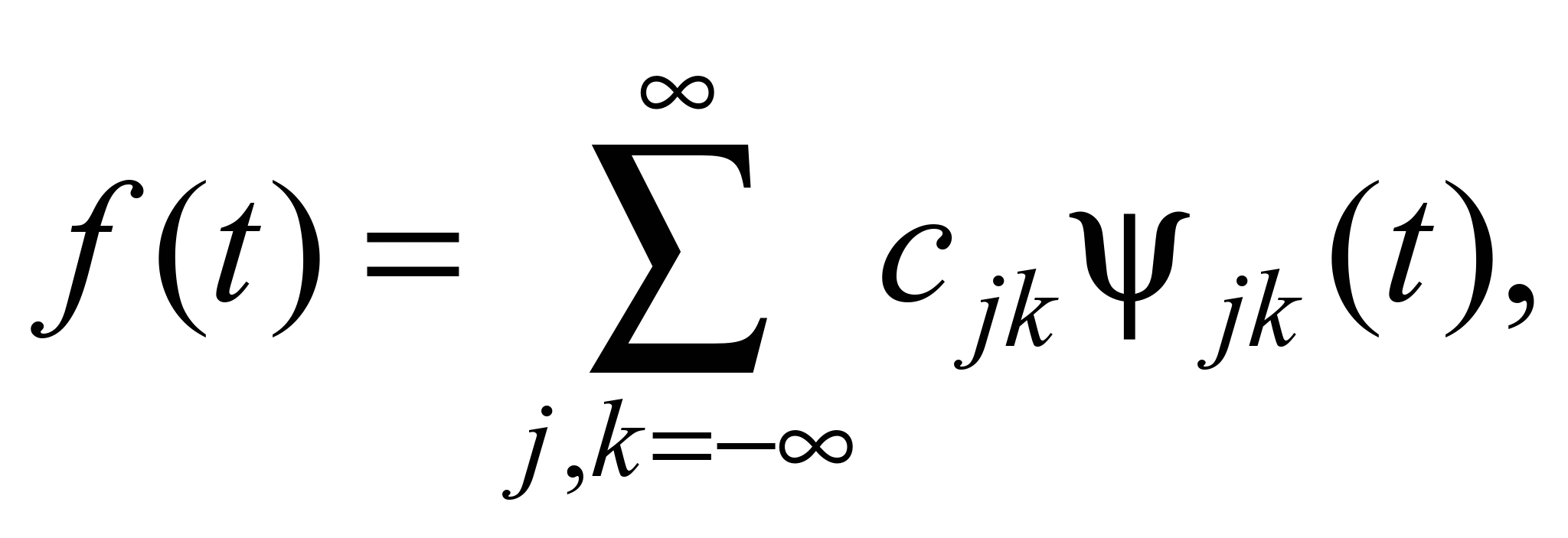
with arbitrary parameters of basis function (which is also called
the mother wavelet) – scaling factor j, and the shift parameter k:

In addition to Fourier transform one can use for
signal processing the Short Time Fourier Transform, which is the
time, frequency and amplitude function. However, considering the
«Heisenberg Uncertainty Principle», this method of processing does
not give the opportunity to measure the frequency and time with high
accuracy. In turn, the wavelet decomposition makes it possible to
reduce the influence of «Heisenberg uncertainty principle» on the
obtained time-frequency representation of the signal, where the
shift of mother wavelet can be considered as the time elapsed from
the time t=0 (since it shows the wavelet location in time), and the
scale is the quantity inverse to the frequency.
By analyzing the time intervals equal to the
duration of pulses and frequency components contained in it, it is
possible to fix the presence of the corresponding code. At this the
interference frequency appearing outside the time pulse intervals,
even repeating the basic carrier frequency will not carry a critical
information load, which in turn will prevent erroneous decryption of
the code [4, 12, 14].
Findings
Firstly, it was taken the signal containing in-formation on a green
signal indication (G code), without interferences, obtained in the
actual operating conditions (Fig. 1). Using the MATLAB programs let
us carry out the Fourier transform (Fig. 2) [9, 10, 11] on this
signal. Analyzing the Fig. 2, we can see the maximum amplitude surge
is at the frequency of 50 Hz and the signal current harmonics is at
the frequencies multiples of 50. Since this signal has the correct
amplitude and time parameters, we accept it as a reference.
Further we expand this signal by continuous one-dimensional wavelet
decomposition with the help of MATLAB pack (Fig. 3), using the
Daubechies wavelet with a center frequency of 0.7143 Hz.
In the first field is the amplitude-time characteristic of the
signal, in the second field is the wavelet spectrum in which using
the color gradation are shown:
the minimal frequencies, which are present in the signal using dark
brown color;
maximal frequencies (in this case 50 Hz) that are present in the
signal using the milky white color.
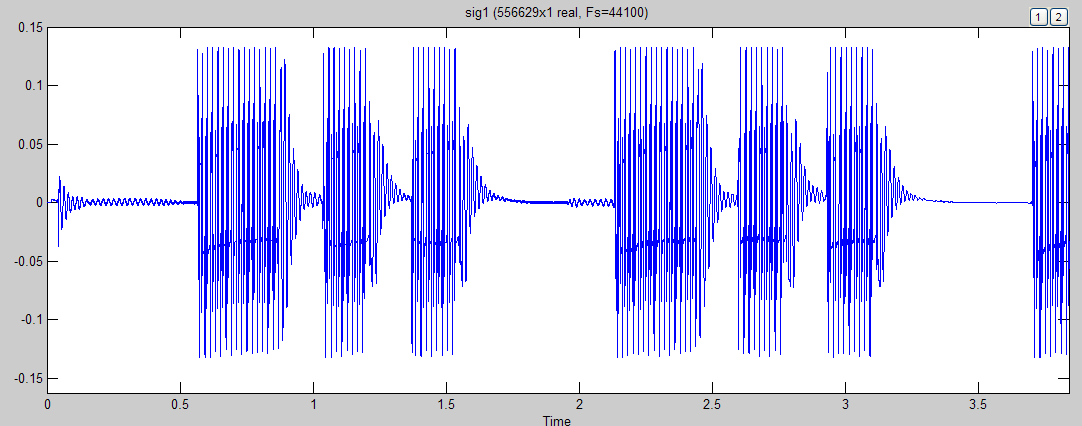
Fig. 1. Code of green fire

Fig. 2. The spectral composition of green fire code
It can be seen that the entire period of time interval of the code G
pulse is filled with the maximal frequency (50 Hz). Time intervals
of pauses are not sharp; the signal frequency is reduced and
gradually comes to zero. This informs that the signal current in
these sections (almost black sections of the spectrum) disappeared.
As in the case of Fourier transform, the wavelet function is
characterized by coefficients. But in this case, we are talking
about the scale factors (scale), which are visualized in the third
field of the Fig. 3. Local maxima of these coefficients are in the
fourth field of the Figures. If we draw an analogy with the
time-frequency dependency, then the scale will be the reverse value
to the frequency, since the small scales correspond to the upper
frequencies of the analyzed signal, and the large scales – to the
lower frequencies.
This dependence is easy to trace in the Fig. 4. Here on the scale of
the range 1-97 pulses and pauses of green code are clearly visible,
and on the scale of the range 129-577 pauses are filled with tapered
continuous graph of dark brown color. This indicates the presence of
low-frequency interferences, which are not essential for decoding
the code almost in the entire time interval of the signal current
presence [15].
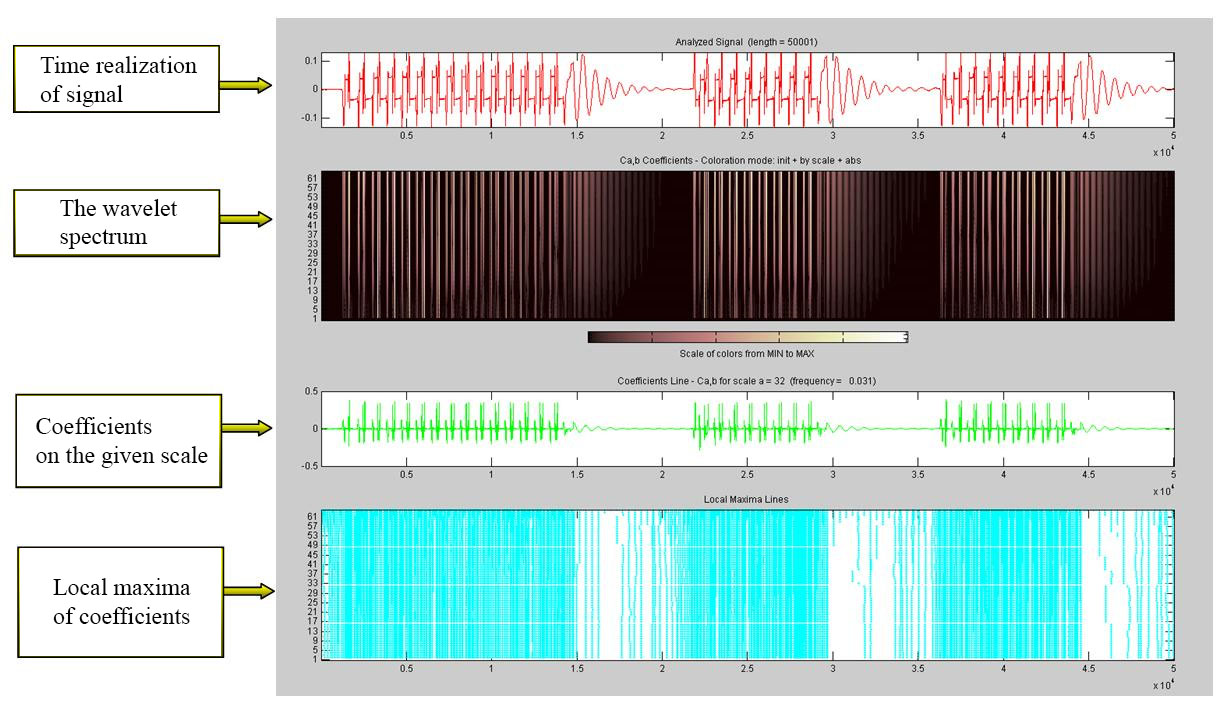
Fig. 3. The spectral
composition of green fire code
in continuous one-dimensional
wavelet decomposition
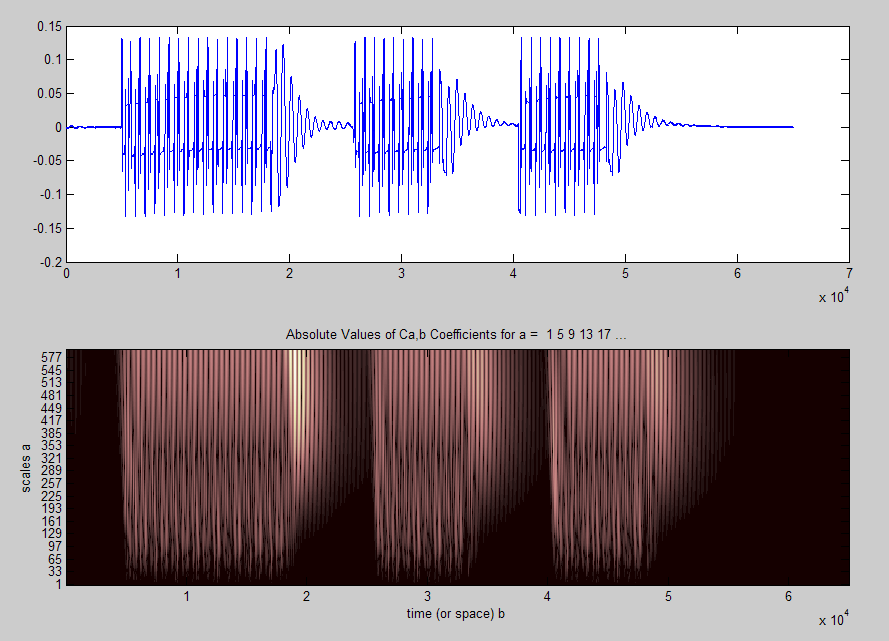
Fig. 4. Time-frequency
dependence of green fire code
during
continuous one-dimensional wavelet decomposition
The Fig. 5 shows noisy signal in comparison with
the reference one, which contains information about green signal
indication (G code) obtained under real operating conditions. The
figure shows that there is high amplitude of interference, the time
of occurrence of which coincides with the time slot of the G code
intervals, resulting in their considerable distortions. Using MATLAB
let us carry out the Fourier transform on this signal (Fig. 6).
Analyzing the Figure 6, it can be noted that some part of
interferences has significant spikes at higher frequencies of 380,
620, 1020 Hz, which cannot result in erroneous decoding of code, and
the other part of interferences coincides with the carrier frequency
of 50 Hz, which could have a fundamental importance to identify the
boundaries of the intervals and pauses.
Let us apply continuous one-dimensional wavelet decomposition with
the help of MATLAB package (Fig. 7) to the one period of G code
using the Daubechies wavelet as in the first example. In this Figure
it is clearly seen that the first pause of the G code is filled by
the interferences, which coincide with the carrier frequency of 50
Hz (white-milky color of the verticals). Having the ability to
monitor the frequency, which is not localized in time, the
interference data may cause incorrect decryption of the code.
Wavelet analysis gives the possibility to track the presence of the
carrier frequency in relation to the time of existence of the
spectral component that enables more correct signal decoding.
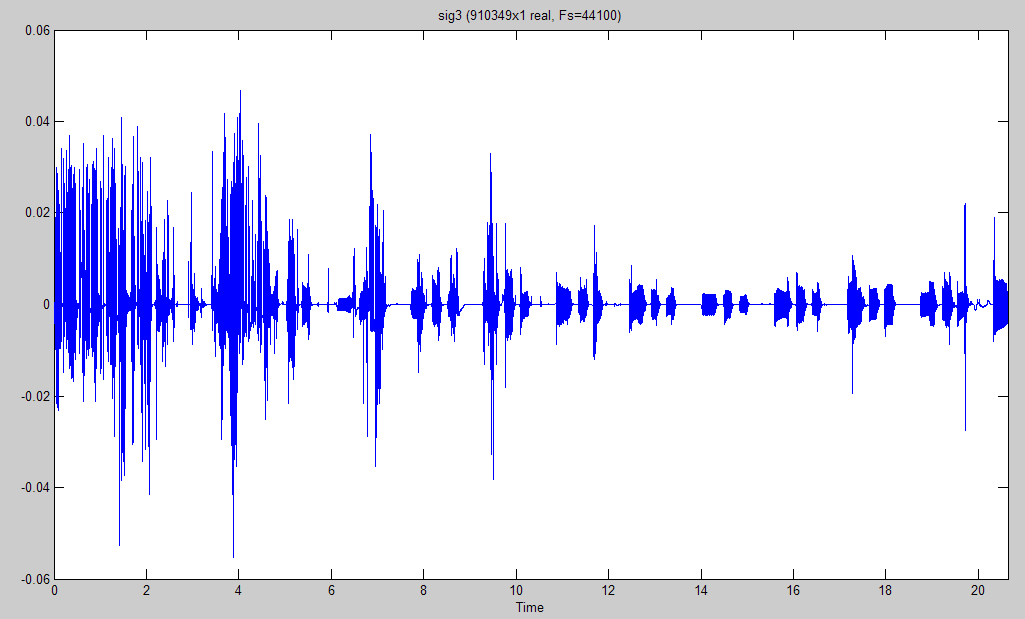
Fig. 5.
The green light code containing significant
interferences
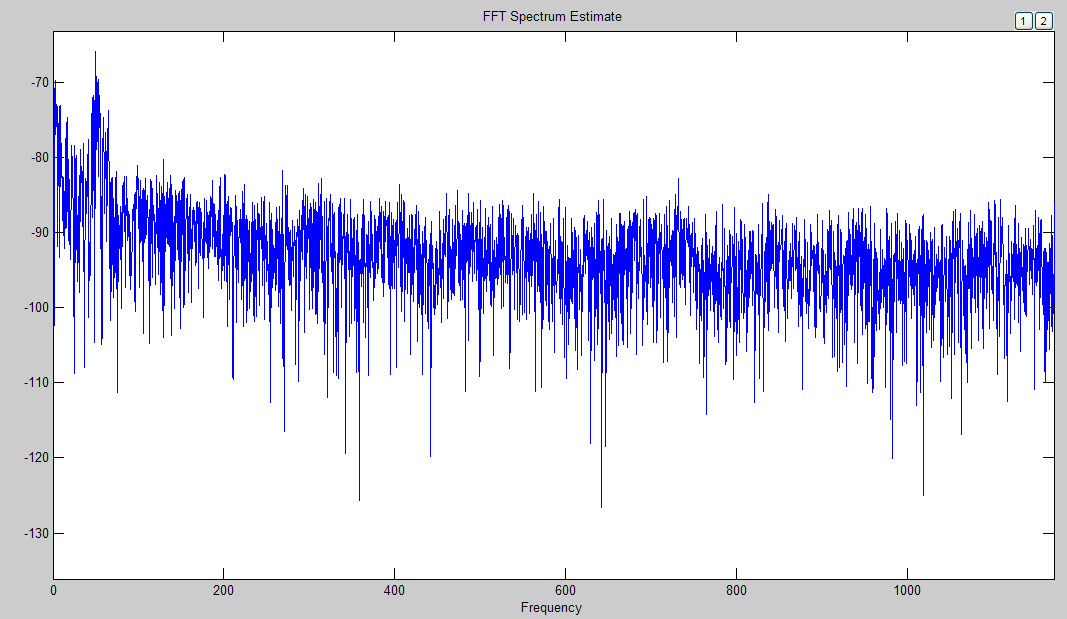
Fig. 6. The spectral composition of the green light
code
containing significant interferences
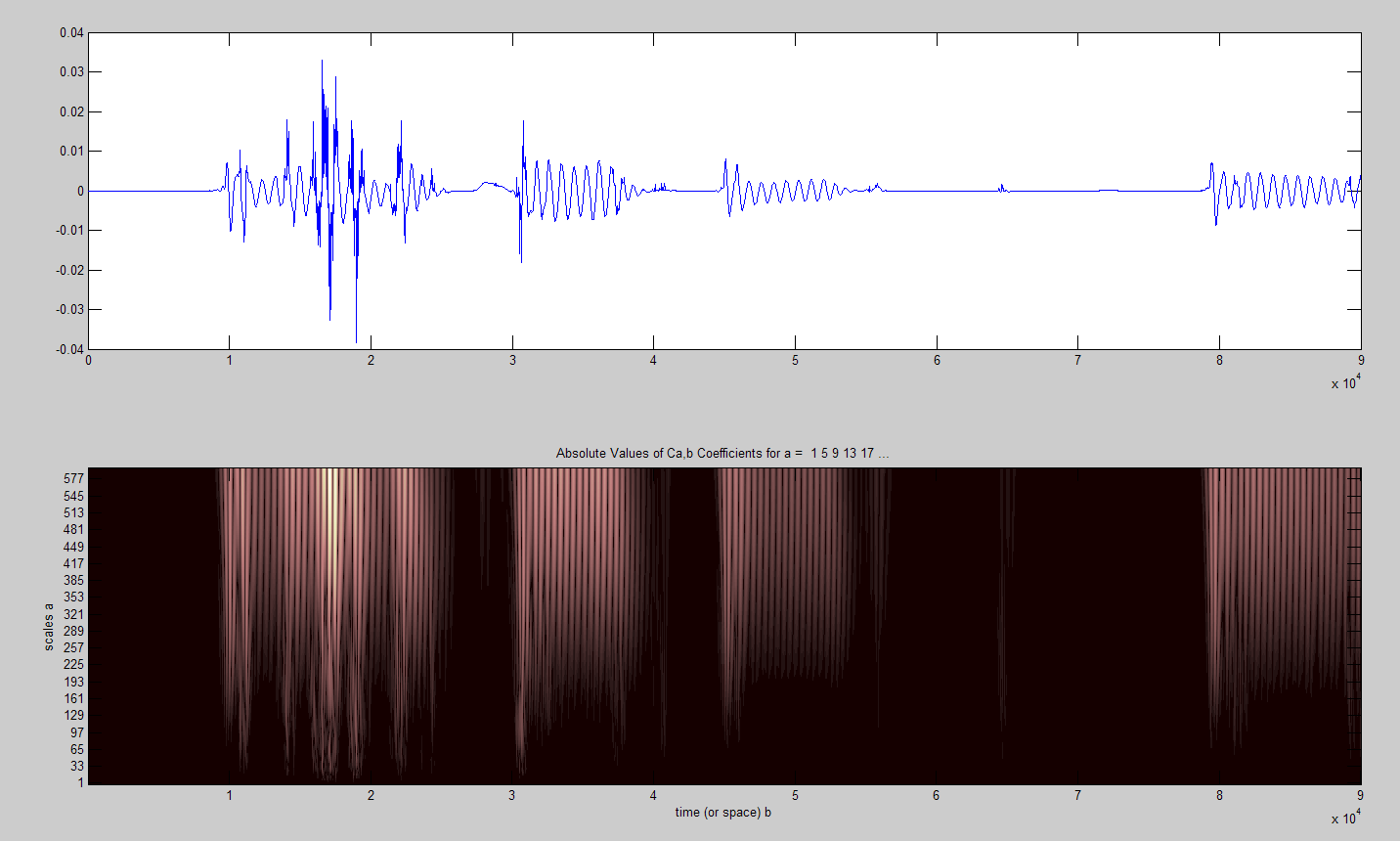
Fig. 7.
Time-frequency dependence of green fire code
with
interferences during
continuous one-dimensional wavelet transformation
Originality
and practical value
Upgrading existing ALSC system involves replacing relay by the
microprocessor hardware, which has a huge number of advantages. In
turn, the digital processing of the received code signal increases
reliability that reduces the number of failures in the system
operation.
Digital processing of the signal involves the use of a mathematical
tool to convert the signal in order to obtain more information about
it, which is not available in its original form. Among many
well-known signal transformations, such as the Short Time Fourier
Transform, Wigner transform and others, the most popular is the
classical Fourier transform. By Fourier series expansion of the
signal one can determine the value of amplitude and phase both of
the studied signal and the interferences, affecting the work of ALSC
devices, as well as the distribution density of probability of the
code signals, interferences and their statistical characteristics
[1, 5, 13]. But there are some disadvantages of this analysis:
the limited informative value of the
nonstationary signal analysis and the fact that it is almost
impossible to analyze their peculiarities (breaks, steps, peaks,
etc.), since their «dissipation» in the entire frequency range of
the spectrum takes place;
representation of the global information about
the frequencies of the studied signal and the lack of
representation of the local signal properties with rapid temporal
changes in its spectral composition.
Therefore, it is necessary a mathematical optimal
signal processing method that can take into account these drawbacks.
In this article the wavelet decomposition is considered as a
possible alternative, which has all the advantages of Fourier
transforms, but it has a number of advantages:
– wavelet bases can be well localized in both
frequency and time;
– wavelet bases can be represented by variety
of basic functions, the properties of which are focused on the
solution of various problems.
This article WD is used to analyze the ALSC
signal code, the expansion of the reference and the noisy G code
followed by conclusions about the peculiarities of this expansion is
carried out. Based on the above mentioned method of the code signal
study one can develop a dynamic model of receiver and ALSC decoder,
in which the module of digital signal processing applying the
wavelet decomposition will be used. This will increase the
interference immunity of the locomotive ALSC devices as a whole.
Conclusions
Sending messages about the signals of track traffic lights or the
block sections vacancy using the ALSC to the moving locomotive is
carried out by electrical signals which are transmitted along the
rails and are perceived by the locomotive receiver. The messages
during transmission are subjected to distortions that may occur when
converting a message during transmission or reception and under the
influence of interferences.
Considerable part of interferences may enter the
frequency range of the useful signal component and lead to failures
in the ALSC operation. Signal decoding and analyzing it in the
amplitude-frequency domain, which can be carried out using the FT
does not provide comprehensive information about the received code.
Information on the signal local features can be obtained by
expanding it in the time-frequency domain using WD.
However, wavelet analysis cannot always
substitute the Fourier analysis. Many theorems of wavelet analysis
are proved by Fourier expansions. Thus, these two types of analysis
are rather complementary than mutually exclusive. Improvement of
decoding principles by using modern technical devices and methods of
digital signal processing are promising for the development of ALSC
receiver with high reliability of noisy signals reception [18].
LIST OF REFERENCE LINKS
Алексеев, К.
А. Очерк
«Вокруг CWT» [Electronic
resource] / К.
А. Алексеев.
– Available at:
http://matlab.exponenta.ru/wavelet/book3/index.php. – Title
from the screen. – Accessed :
30.01.2017.
Ананьева, О. М. Прием сигналов
АЛСН в условиях действия двухкомпонентной
помехи /
О. М. Ананьева, М. Г. Давиденко
// Інформ.-керуючі системи на залізн.
трансп. – 2015. – Вип. 5. –
С. 52–56. doi:
10.18664/ikszt.v0i5.55748.
Ананьева,
О. М. Синтез нелинейного
приемника сигналов АЛСН в условиях
действия аддитивной двухкомпонентной
помехи / О. М. Ананьева,
М. Г. Давиденко //
Інформ.-керуючі системи на залізн.
трансп. – 2015. – №
6. – С. 46–50.
doi: 10.18664/ikszt.v0i6.60191.
Астафьева, Н. М. Вейвлет-анализ:
основы теории и примеры применения /
Н. М. Астафьева // Успехи физических
наук. – 1996. – Т. 166, № 11. – С. 1145–1170. doi:
10.3367/UFNr.0166.199611a.1145.
Баскаков, С. И. Радиотехнические
цепи и сигналы / С. И. Баскаков. – Москва
: Высш. шк., 2000. – 448с.
Бойник, А. Б. Корреляционный
прием и дешифрация кода АЛСН по
спектральному признаку /
А. Б. Бойник, М. Н.
Чепцов, А. М. Трунаев //
Інформ.-керуючі системи на залізн.
трансп. – 2008. – № 2. – С.
64–68.
Бушуев, В. И. Явление
феррорезонанса в фазочувствительных
рельсовых цепях частотой 50 Гц /
В.
И. Бушуев, С. В. Бушуев // Автоматика,
связь, информатика. – 2004. – № 3. – С.
31–32.
Гаврилюк, В. И. Испытания новых
типов подвижного состава на
электромагнитную совместимость с
устройствами сигнализации и связи /
В. И. Гаврилюк, В. И. Щека, В. В. Мелешко
// Наука та прогрес транспорту. – 2015. –
№ 5 (59). – С. 7–15. doi:
10.15802/stp2015/55352.
Дремин, И. М. Вейвлеты и их
использование / И. М. Дремин, О. В. Иванов,
В. А. Нечитайло // Успехи физических
наук. – 2001. – Т. 171, № 5. – С. 465–501. doi:
10.3367/UFNr.0171.200105a.0465.
Дьяконов, В. П. Вейвлет-анализ
в MATLAB реальных осциллограмм
[Electronic resource]
/ В. П. Дьяконов // Измерения в технике
и связи. – С. 19–25. – Available
at:
http://www.tmi-s.com/upload/kipis_articles/article_Dyakonov_3-2010.pdf.
– Title from
the screen. –
Accessed : 27.01.2017.
Дьяконов, В. MATLAB. Обработка
сигналов и изображений : спец. справ.
/ В. Дьяконов, И. Абраменкова. –
Санкт-Петербург : Питер, 2002. – 608 с.
Илюшин, Я. А. Теория и применение
вейвлетов / Я. А. Илюшин // Вейвлеты. –
2009. – 1 эл. опт. диск (CD-ROM).
Каганов, В. И. Радиотехника+компьютер+Math
CAD / В. И. Каганов. – Москва :
Горячая линия, 2001. –413 с.
Левкович-Маслюк, Л. Введение в
вейвлет-анализ : учеб. курс / Л.
Левкович-Маслюк, А. Переберин. – Москва
: ГрафиКон’99, 1999.
– 218 с.
Мистецкий, В. Разработка.
Непрерывное wavelet
преобразование [Electronic
resource] / В.
Мистецкий // Хабрахабр. – 2010. – Available
at: https://habrahabr.ru/post/103899/.
– Title from
the screen.
– Accessed :
17.01.2017.
Новиков, Л. В. Основы вейвлет-анализа
сигналов : учеб. пособие / Л. В. Новиков.
– Санкт-Петербург : ИАнП РАН. –1999. –
152 с.
Смоленцев, Н. К. Основы теории
вейвлетов. Вейвлеты в MATLAB
/ Н. К. Смоленцев. – Москва : ДМК Пресс,
2005. – 304 с.
Cотник, В.
О. Нейромережева модель розпізнавання
тривалості імпульсів та
інтервалів кодів АЛСН /
В. О.
Cотник, М. М.
Бабаєв, М. М. Чепцов
// Зб. наук.
пр. Донец.
ін-ту залізн. трансп. – Донецьк,
2013. – Вип.
36. – С.
67–78.
Чепцов,
М. Н. Метод определения параметров
безопасности программного обеспечения
в микропроцессорных системах управления
движением поездов / М. Н. Чепцов // Зб.
наук. пр. Донец. ін-ту залізн. трансп. –
Донецьк, 2005. – Вип. 2. –
С. 39–45.
Djukanovic,
S. A
Parametric Method
for Multicomponent
Interference Suppression
in Noise Radars
/ S. Djukanovic,
V. Popovic //
IEEE Transactions
on Aerospace
and Electronic
Systems. – 2012. – Vol.
48. – Iss. 3. – P.
2730–2738. doi:
10.1109/taes.2012.6237624.
Lewalle, J.
Введение в анализ данных с применением
непрерывного вейвлет-преобразования
[Electronic resource]
/ J. Lewalle
; пер. с англ. Грибунина
В. Г –
Available at:
http://www.autex.spb.su/download/wavelet/books/lewalle.pdf.
– Title from the screen. – Accessed : 27.01.2017.
Polikar, R. Введение
в вейвлет-преобразование
[Electronic resource] / R. Polikar ; пер.
с англ.
Грибунина В.
Г. – Available at:
http://www.autex.spb.su/download/wavelet/books/tutorial.pdf.
– Title from the screen. – Accessed : 27.01.2017.
Said, A. A New Fast and Efficient
Image Codec Based on Set Partitioning in Hierarchical Trees /
А. Said,
W.
A. Pearlman //
Transactions
on Circuits and Systems for Video Technology.
– 1996. – Vol. 6. – Iss. 3. –
P.
243–250. doi: 10.1109/76.499834.
Study of transmission lines effect
on the system operation of continuous automatic cab signaling /
O.
O. Hololobova, V. I. Havryliuk, M. O.
Kovryhin, S. Yu. Buriak // Наука та
прогрес транспорту.
– 2014.
– № 5 (53)
– С. 17–28.
doi: 10.15802/stp2014/30833.
О. О. ГОЛОЛОБОВА1*,
В. І. ГАВРИЛЮК2
1*Каф.
«Автоматика, телемеханіка та зв’язок»,
Дніпропетровський національний
університет залізничного
транспорту
імені академіка В. Лазаряна, вул.
Лазаряна, 2, Дніпро, Україна, 49010, тел.
+38 (056) 373 15 04,
ел. пошта gololobova_oksana@i.ua,
ORCID 0000-0003-1857-8196
2Каф. «Автоматика,
телемеханіка та зв’язок», Дніпропетровський
національний університет залізничного
транспорту імені академіка В. Лазаряна,
вул. Лазаряна, 2, Дніпро, Україна, 49010,
тел. +38 (056) 373 15 04,
ел. пошта gvi_dp@mail.ru,
ORCID 0000-0001-9954-4478
ЗАСТОСУВАННЯ ПЕРЕТВОРЕННЯ
ФУР’Є І ВЕЙВЛЕТ-ПЕРЕТВОРЕННЯ
ДЛЯ
ДЕШИФРАЦІЇ КОДУ АЛСН
Мета.
Існуюча система автоматичної локомотивної
сигналізації (АЛС) була розроблена в
кінці минулого століття. У даній системі
використовується принцип числового
коду, реалізований на базі релейної
техніки, у зв’язку з чим вона схильна
до впливу різних перешкод. За минулі
роки система була неодноразово
модернізована, але причини збоїв та
відмов у її роботі, як і раніше, залишаються
предметом досліджень. Відомо, що частотна
і фазова модуляція сигналу має вищу
завадостійкість у порівнянні з
амплітудною модуляцією. Тому в роботі
була поставлена мета – дослідити
можливість застосування частотних
методів, таких як розкладання в ряд
Фур’є та вейвлет-перетворення для
вилучення із сигналів АЛС інформаційної
складової про прийнятий код в умовах
дії різних перешкод. Методика.
За допомогою дослідження сигналу в
частотній області можна витягти
інформацію, недоступну в тимчасовому
поданні сигналу. Для цієї мети було
використано вейвлет-перетворення, яке
дає можливість представляти локальні
особливості сигналу та забезпечувати
частотно-часове розкладання відразу
в двох просторах. Завдяки високій
точності представлення сигналу
з’являється можливість аналізувати
тимчасову локалізацію спектральних
компонентів і виключити складові
перешкод, навіть у разі збігу частоти
перешкоди з частотою сигналу. Результати.
Для порівняння інформативності методів
розкладання Фур’є та вейвлет-перетворення
було досліджено за допомогою програмного
пакету MATLAB еталонний та зашумленний
сигнал коду зеленого вогню. Докладний
аналіз отриманих спектральних
характеристик показав, що вейвлет-перетворення
дає більш коректну дешифрацію сигналу.
Наукова новизна.
Заміна електромагнітних реле в системі
АЛС на мікропроцесорну апаратуру
передбачає застосування будь-якого
математичного інструменту для
дешифрування коду з метою отримання
про нього додаткової інформації.
Найчастіше, як математичний інструмент,
використовується класичне перетворення
Фур’є. Але, в силу наявності ряду
недоліків в даному методі, було
запропоновано використовувати
вейвлет-перетворення, яке має ряд
переваг і враховує недоліки перетворення
Фур’є. Практична
значимість. Наведений
метод дослідження кодового сигналу
можна покласти в основу розробки
динамічної моделі приймача і дешифратора
АЛС із використанням модуля цифрової
обробки, що дасть можливість підвищити
надійність та достовірність вилучення
інформаційної складової коду.
Ключові слова: автоматична
локомотивна сигналізація; перетворення
Фур’є; вейвлет-перетворення;
завадостійкість; амплітудна модуляція;
зрушення; масштаб; частотно-тимчасова
область
о. а. гололобова1*, в. И.
гаврилюк2
1*Каф.
«Автоматика, телемеханика и связь»,
Днепропетровский национальный
университет железнодорожного
транспорта
имени академика В. Лазаряна, ул. Лазаряна,
2, Днипро, Украина, 49010, тел. +38 (056) 373 15 04,
эл. почта gololobova_oksana@i.ua, ORCID
0000-0003-1857-8196
2Каф. «Автоматика,
телемеханика и связь», Днепропетровский
национальный университет железнодорожного
транспорта имени академика В. Лазаряна,
ул. Лазаряна, 2, Днипро, Украина, 49010, тел.
+38 (056) 373 15 04,
эл. почта gvi_dp@mail.ru,
ORCID 0000-0001-9954-4478
Применение преобразования
фурье
и вейвлет-преобразования
для
дешифрации кода АЛСН
Цель. Существующая
система автоматической локомотивной
сигнализации (АЛС) была разработана в
конце прошлого века. В данной системе
используется принцип числового кода,
реализованный на базе релейной техники,
в связи с чем она подвержена влиянию
различных помех. За прошедшие годы
система была неоднократно модернизирована,
но причины сбоев и отказов в ее работе
по-прежнему остаются предметом
исследований. Известно, что частотная
и фазовая модуляция сигнала имеет более
высокую помехоустойчивость в сравнении
с амплитудной модуляцией. Поэтому в
работе была поставлена цель – исследовать
возможность применения частотных
методов, таких как разложение в ряд
Фурье и вейвлет-преобразование для
извлечения из сигналов АЛС информационной
составляющей о принимаемом коде в
условиях действия различных помех.
Методика. С
помощью исследования сигнала в частотной
области можно извлечь информацию,
недоступную во временном представлении
сигнала. Для этой цели было использовано
вейвлет-преобразование, которое дает
возможность представлять локальные
особенности сигнала и обеспечивать
частотно-временное разложение сразу
в двух пространствах. Благодаря высокой
точности представления сигнала
появляется возможность анализировать
временную локализацию спектральных
компонент и исключить составляющие
помех, даже в случае совпадения частоты
помехи с несущей частотой сигнала.
Результаты. Для
сравнения информативности методов
разложения Фурье и вейвлет-преобразования
был исследован с помощью программного
пакета MATLAB эталонный и зашумленный
сигнал кода зеленого огня. Подробный
анализ полученных спектральных
характеристик показал, что
вейвлет-преобразование дает более
корректную дешифрацию сигнала. Научная
новизна. Замена
электромагнитных реле в системе АЛС
на микропроцессорную аппаратуру
предполагает применение какого-либо
математического инструмента для
дешифрации кода с целью получения о
нем дополнительной информации. Чаще
всего, как математический инструмент,
используется классическое преобразование
Фурье. Но, в силу наличия ряда недостатков
в данном методе, было предложено
использовать вейвлет-преобразование,
которое имеет ряд преимуществ и учитывает
недостатки преобразования Фурье.
Практическая значимость.
Приведенный метод
исследования кодового сигнала можно
положить в основу разработки динамической
модели приемника и дешифратора АЛС с
использованием модуля цифровой
обработки, что даст возможность повысить
надежность и достоверность извлечения
информационной составляющей кода.
Ключевые слова:
автоматическая локомотивная сигнализация;
преобразование Фурье; вейвлет-преобразование;
помехоустойчивость; амплитудная
модуляция; сдвиг; масштаб; частотно-временная
область
REFERENCES
Alekseev,
K. A. Ocherk «Vokrug CWT». (n.d.). Retrieved from
http://matlab.exponenta.ru/wavelet/book3/index.php
Аnan’yevа, O. M., &
Davidenko M. G. (2015). The reception of the signals of continuous
automatic cab signaling (CACS) under the conditions of
two-component interference effect. Information
and Control Systems at Railway Transport, 5,
52-56. doi: 10.18664/ikszt.v0i5.55748
Аnan’yevа, O. M., &
Davidenko, M. G. (2015). Synthesis of the nonlinear receiver of
CACS signals in the conditions of the additive two-component
interference.
Information and Control Systems at Railway Transport, 6,
46-50. doi: 10.18664/ikszt.v0i6.60191
Astaf’eva,
N. M. (1996). Wavelet analysis: basic theory and some applications.
Uspekhi
Fizicheskikh Nauk,
11(166),
1145-1170. doi: 10.3367/UFNr.0166.199611a.1145
Baskakov, S. I. (2000).
Radiotekhnicheskiye
tsepi i signaly.
Moscow: Vysshaya shkola.
Boynik, A. B., Cheptsov, M. N., &
Trunaev, A. M. (2008). Korrelyatsionnyy priyem i deshifratsiya koda
ALSN po spektralnomu priznaku. Information
and Control Systems at Railway Transport, 2,
64-68.
Bushuev, V. I., & Bushuev, S.
V. (2004). Yavleniye ferrorezonansa v fazochuvstvitelnykh relsovykh
tsepyakh chastotoy 50 Gts. Automation,
Communication and Informatics, 3,
31-32.
Havrilyuk, V. I., Shcheka, V. I., &
Meleshko, V. V. (2015). Testing New Types of Rolling Stock for
Electromagnetic Compatibility with Signaling and Communication
Devices. Science
and Transport Progress,
5(59),
7-15. doi: 10.15802/stp2015/55352
Dremin,
I. M., Ivanov,
O. V., & Nechitailo,
V. A. (2001). Wavelets and their uses. Uspekhi
Fizicheskikh Nauk,
5(171),
465-501. doi:
10.3367/UFNr.0171.200105a.0465
Dyakonov, V. (2010). Wavelet signal
analysis of actual oscillograms using Math. Test
& Measuring Instruments and Systems, 3,
19-25. Retrieved from
http://www.tmi-s.com/upload/kipis_articles/article_Dyakonov_3-2010.pdf
Dyakonov, V. & Abramenkova, I.
(2002). MATLAB.
Obrabotka signalov i izobrazheniy: spetsialnyy spravochnik.
Saint Petersburg: Piter.
Ilyushin, Y. A. (2009). Teoriya
i primeneniye veyvletov.
[CD].
Kaganov, V. I. (2001).
Radiotekhnika+kompyuter+Math
CAD. Moscow:
Goryachaya liniya.
Levkovich-Maslyuk, L., &
Pereberin, A. (1999). Vvedeniye
v veyvlet-analiz.
Moscow: GrafiKon’99.
Mistetskiy, V. (2010). Razrabotka.
Nepreryvnoye wavelet preobrazovaniye. Habrahabr.
Retrieved from https://habrahabr.ru/post/103899/
Novikov, L. V. (1999). Osnovy
veyvlet-analiza signalov.
St. Petersburg: IAI RAS.
Smolentsev, N. K. (2005). Osnovy
teorii veyvletov. Veyvlety v MATLAB.
Moscow: DMK Press.
Cotnyk, V. O., Babaiev, M. M., &
Cheptsov, M. M. (2013). Neiromerezheva model rozpiznavannia
tryvalosti impulsiv ta intervaliv kodiv ALSN. Zbirnik
naukovih prac' of Donetsk Railway Transport Institute, 36,
67-78.
Cheptsov, M. M. (2005). The method
of determination of parameters software safety in microsystems by
moving the trains. Zbirnik
naukovih prac' of Donetsk Railway Transport Institute,
2,
39-45.
Djukanovic, S., & Popovic, V.
(2012). A Parametric Method for Multicomponent Interference
Suppression in Noise Radars. IEEE
Transactions on Aerospace and Electronic Systems, 48(3),
2730-2738. doi:
10.1109/taes.2012.6237624
Lewalle, J. (n.d.) Vvedeniye
v analiz dannykh s primeneniyem nepreryvnogo
veyvlet-preobrazovaniya
(V. G. Gribunin, Trans.). Saint Petersburg Autex. Retrieved from
http://www.autex.spb.su/download/wavelet/books/lewalle.pdf
Polikar, R. (n.d.) Vvedeniye
v veyvlet-preobrazovaniye
(V. G. Gribunin, Trans.). St. Petersburg: Autex. Retrieved from
http://www.autex.spb.su/download/wavelet/books/tutorial.pdf
Said, A., & Pearlman, W. A.
(1996). A New Fast and Efficient Image Codec Based on Set
Partitioning in Hierarchical Trees. Transactions
on Circuits and Systems for Video Technology,
6(3),
243-250. doi: 10.1109/76.499834
Hololobova, O. O., Havryliuk, V.
I., Kovryhin, M. O., & Buriak, S. Y. (2014). Study of
transmission lines effect on the system operation of continuous
automatic cab signaling. Science
and Transport Progress,
5(53),
17-28. doi: 10.15802/stp2014/30833
Prof. A. V. Kovalenko, D. Sc.
(Phys.-Math.);
Associate Prof.
V. I. Profatilov, Ph.D.
(Tech.) recommended
this article to be published)
Accessed: Oct. 12, 2016
Received: Jan. 04, 2017
,